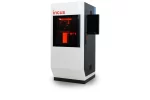Azoth 3D adds Incus LMM for metal 3D printing
Azoth 3D, a U.S.-based additive manufacturing service provider specializing in metal components, has adopted the Hammer Lab35 system to expand its production capacity. The new lithography-based metal manufacturing (LMM) technology enables Azoth 3D to produce small, high-resolution parts with lead times of 5 to 7 days, significantly reducing turnaround times for industries requiring complex metal geometries.
Incus, an Austrian company focused on photopolymerization-based metal 3D printing, developed the Hammer Lab35 to deliver detailed components with fine surface finishes. The system uses a light-based process to selectively solidify metal powder mixed in a photopolymer binder, allowing for high feature resolution and clean part edges. Azoth 3D is applying the system to three critical industrial materials: 316L stainless steel, 17-4 PH stainless steel, and titanium. These are used across sectors such as medical device manufacturing, aerospace, automotive tooling, and defense applications.
“Incus’ LMM technology allows us to bridge the gap between rapid prototyping and end-use production with an unmatched lead time of just 5–7 days,” said Cody Cochran, General Manager and Co-Founder of Azoth 3D. Denise Modder, head of application engineering at Incus, added, “The Hammer Lab35’s ability to produce fine-detail metal parts with exceptional surface quality aligns perfectly with Azoth 3D’s vision for rapid and efficient production.”
Material flexibility is central to the new system’s appeal. 316L stainless steel, known for its corrosion resistance, is widely used in marine, food, and surgical applications. 17-4 PH stainless steel offers high mechanical strength and hardness, making it suitable for structural parts in demanding mechanical environments. Titanium, which Azoth already uses in production, provides a high strength-to-weight ratio and corrosion resistance for use in medical implants, aerospace assemblies, and high-performance defense equipment.
The Hammer Lab35 system. Photo via Incus.
To request a quote from Azoth 3D, visit azoth3d.com/quote.
Recent Advances in Metal 3D Printing
Growing demand for accessible metal additive manufacturing systems has led to open-source innovations such as the ReAM250 project, developed by researchers at the Technical University of Munich. The initiative provides complete documentation for building a modular laser powder bed fusion (LPBF) 3D printer using off-the-shelf components. By releasing software, CAD files, and control system diagrams under a permissive BSD license, the project aims to lower R&D costs and accelerate experimentation with process monitoring and control. Supported by Autodesk and RAYLASE, the platform integrates programmable lasers and scan controllers to enable precise beam shaping, while Autodesk’s open-source Machine Control Framework allows full integration with industrial design software.
In parallel, large-scale industrial metal 3D printing is also evolving. AddUp, a French manufacturer of LPBF systems, recently unveiled the first prototype developed under its MASSIF initiative, a collaborative project targeting high-productivity, eco-friendly additive manufacturing. Designed for a 750 × 750 × 1000 mm build volume, the new system is expected to cut production costs by up to 70% and reduce material waste to under 10%. The printer incorporates real-time defect detection and surface finishing capabilities to minimize post-processing. Industry partners such as Dassault Systèmes, ISP Systems, and CETIM are contributing virtual modeling tools, laser beam shaping technologies, and validation environments to help transition the platform from prototype to industrial deployment.
The ReAM250 open-source metal 3D printer. Image via Technical University of Munich.
Ready to discover who won the 20243D Printing Industry Awards?
Subscribe to the 3D Printing Industry newsletter to stay updated with the latest news and insights.
Featured image shows the Hammer Lab35 system. Photo via Incus.
Anyer Tenorio Lara
Anyer Tenorio Lara is an emerging tech journalist passionate about uncovering the latest advances in technology and innovation. With a sharp eye for detail and a talent for storytelling, Anyer has quickly made a name for himself in the tech community. Anyer's articles aim to make complex subjects accessible and engaging for a broad audience. In addition to his writing, Anyer enjoys participating in industry events and discussions, eager to learn and share knowledge in the dynamic world of technology.


